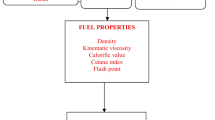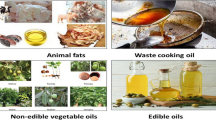Abstract
Stringent emission norms impose challenges to original equipment manufacturer (OEM) in reducing diesel engine emissions. Implementing renewable fuels as alternative energy sources in diesel engines leads to increased emission levels particularly NOx. In this work, performance, combustion, and emission parameters from a diesel engine powered with grapeseed oil biodiesel (GSBD) was investigated. Nano additive emulsions of cerium oxide (CeO2) and zinc oxide (ZnO) at 100 ppm each were added to grapeseed oil biodiesel. To enhance the NOx reduction task further, an advanced technology called selective catalytic reduction (SCR) system was used. With easy availability of aqueous urea, careful injection, and distribution of the reductant solution, a paradigm change was brought about in NOx reduction technology. The experiments were carried out with and without SCR for better understanding and investigation. The percentage reduction of NOx emission by adding cerium oxide and zinc oxide emulsion blends were 4.19% and 13.13%, respectively. The overall reduction in NOx emission were 74.16% and 80.06% with SCR for cerium oxide and zinc oxide emulsion blends. The research conclusions make grapeseed oil biodiesel conceivable as an effective alternate fuel for diesel engines without any engine modifications.

















Similar content being viewed by others
Abbreviations
- GSBD :
-
grapeseed biodiesel
- DOC :
-
diesel oxidation catalyst
- DPF :
-
diesel particulate filter
- NO x :
-
nitrogen oxide, specifically NO and NO2
- SCR :
-
selective catalytic reduction
- ZnO :
-
zinc oxide
- CeO 2 :
-
cerium oxide
- BTE :
-
brake thermal efficiency
- HC :
-
hydrocarbons
- PM :
-
particulate matter
- CO :
-
carbon monoxide
- BSFC :
-
brake-specific fuel consumption
- EGR :
-
exhaust gas temperature
- THC :
-
total hydrocarbons
- UBHC :
-
unburned hydrocarbons
- CI :
-
compression ignition
- CFD :
-
computational fluid dynamics
- Cu - ZSM5 :
-
copper zeolite Socony Mobil 5
- DOC :
-
diesel oxidation catalyst
- DPF :
-
diesel particulate filter
- NMHC :
-
non-methane hydrocarbons
- AUS 32 :
-
aqueous urea solution
- B20 :
-
20% of biodiesel blended with 80% of diesel
References
Abu-Jrai AM, Ala’a H, Hasan AO (2017) Combustion, performance, and selective catalytic reduction of NOx for a diesel engine operated with combined tri fuel (H2, CH4, and conventional diesel). Energy 119:901–910
Arunkumar M, Kannan M, Murali G (2019) Experimental studies on engine performance and emission characteristics using castor biodiesel as fuel in CI engine. Renew Energy 131:737–744
Ashok B, Nanthagopal K, Saravanan B, Azad K, Patel D, Sudarshan B, Ramasamy RA (2019) Study on isobutanol and Calophyllum inophyllum biodiesel as a partial replacement in CI engine applications. Fuel 235:984–994
Ashok B, Nanthagopal K, Mohan A, Johny A, Tamilarasu A (2017) Comparative analysis on the effect of zinc oxide and ethanox as additives with biodiesel in CI engine. Energy 140:352–364
Ayodhya AS, Lamani VT, Thirumoorthy M, Kumar GN (2019) NOx reduction studies on a diesel engine operating on waste plastic oil blend using selective catalytic reduction technique. J Energy Inst 92(2):341–350
Basha JS (2018) Impact of carbon nanotubes and di-ethyl ether as additives with biodiesel emulsion fuels in a diesel engine–an experimental investigation. J Energy Inst 91(2):289–303
Fisher EM, Pitz WJ, Curran HJ, Westbrook CK (2000) Detailed chemical kinetic mechanisms for combustion of oxygenated fuels. Proc Combust Inst 28(2):1579–1586
Ghazali WNMW, Mamat R, Masjuki HH, Najafi G (2015) Effects of biodiesel from different feedstocks on engine performance and emissions: a review. Renew Sust Energ Rev 51:585–602
Gysel N, Karavalakis G, Durbin T, Schmitz D, Cho A (2014) Emissions and redox activity of biodiesel blends obtained from different feedstocks from a heavy-duty vehicle equipped with DPF/SCR aftertreatment and a heavy-duty vehicle without control aftertreatment (No. 2014-01-1400). SAE Technical Paper.
Huang H, Teng W, Liu Q, Zhou C, Wang Q, Wang X (2016) Combustion performance and emission characteristics of a diesel engine under low-temperature combustion of pine oil–diesel blends. Energy Convers Manag 128:317–326
Jiaqiang E, Zhang Z, Chen J, Pham M, Zhao X, Peng Q, Yin Z (2018) Performance and emission evaluation of a marine diesel engine fueled by water biodiesel-diesel emulsion blends with a fuel additive of a cerium oxide nanoparticle. Energy Convers Manag 169:194–205
Jones RL (1996) Catalytic combustion effects of m-ZrO2 doped with various metal nitrates. Surf Coat Technol 86:127–134
Kašpar J, Graziani M, Fornasiero P (2000) Ceria-containing three-way catalysts. Handbook Phys Chem Rare Earths 29:159–267
Khond VW, Kriplani VM (2016) Effect of nanofluid additives on performances and emissions of emulsified diesel and biodiesel fueled stationary CI engine: a comprehensive review. Renew Sust Energ Rev 59:1338–1348
Kumar AM, Sreekumar JS, Mohanan P (2015) The effect of cordierite/Pt catalyst on the NOx reduction in a diesel and Jatropha bio-diesel operated single cylinder engine. J Environ Chem Eng 3(2):1125–1136
Li B, Song C, Lv G, Fan C, Zhang X, Wen H, Liu J (2019) Redox reaction process between hydrocarbon and adsorbed NOx over lean NOx trap catalyst. Proc Combust Inst 37(4):5455–5463
Logothetidis S, Patsalas P, Charitidis C (2003) Enhanced catalytic activity of nanostructured cerium oxide films. Mater Sci Eng C 23(6-8):803–806
Martin MLJ, Geo VE, Nagalingam B (2017) Effect of fuel inlet temperature on cottonseed oil–diesel mixture composition and performance in a DI diesel engine. J Energy Inst 90(4):563–573
Martin MLJ, Geo VE, Singh DKJ, Nagalingam B (2012) A comparative analysis of different methods to improve the performance of cotton seed oil fuelled diesel engine. Fuel 102:372–378
Michelin J, Guilbaud F, Guil A, Newbigging I, Jean E, Reichert M, Shaikh Z (2014) Advanced compact SCR mixer: BlueBox (No. 2014-01-1531). SAE Technical Paper
Mendes AN, Zholobenko VL, Thibault-Starzyk F, Da Costa P, Henriques C (2016) On the enhancing effect of Ce in Pd-MOR catalysts for NOx CH4-SCR: a structure-reactivity study. Appl Catal B Environ 195:121–131
Najafi G (2018) Diesel engine combustion characteristics using nano-particles in biodiesel-diesel blends. Fuel 212:668–678
Nanthagopal K, Ashok B, Tamilarasu A, Johny A, Mohan A (2017) Influence on the effect of zinc oxide and titanium dioxide nanoparticles as an additive with Calophyllum inophyllum methyl ester in a CI engine. Energy Convers Manag 146:8–19
Perumal V, Ilangkumaran M (2018) The influence of copper oxide nano particle added pongamia methyl ester biodiesel on the performance, combustion and emission of a diesel engine. Fuel 232:791–802
Perumal V, Ilangkumaran M (2017) Experimental analysis of engine performance, combustion and emission using pongamia biodiesel as fuel in CI engine. Energy 129:228–236
Pietikäinen M, Väliheikki A, Oravisjärvi K, Kolli T, Huuhtanen M, Niemi S, Keiski RL (2015) Particle and NOx emissions of a non-road diesel engine with an SCR unit: the effect of fuel. Renew Energy 77:377–385
Praveena V, Martin MLJ (2018a) A review on various after treatment techniques to reduce NOx emissions in a CI engine. J Energy Inst 91(5):704–720
Praveena V, Martin LJ (2018b) Design optimization of urea injectors and mixers in a compact SCR system (No. 2018-28-0025). SAE Technical Paper
Praveena V, Venkatesan S, Anand A, Jain RM (2017) Investigations on the effect of Mahua biofuel blends and load on performance and NOx emissions of diesel engine using response surface methodology. International Journal of Mechanical Engineering and Technology, 8(8)
Rajak U, Verma TN (2018) Effect of emission from ethylic biodiesel of edible and non-edible vegetable oil, animal fats, waste oil and alcohol in CI engine. Energy Convers Manag 166:704–718
Sharma S, Gupta S, Kumar N, Kumar S (2014) Comparative study on performance and emission characteristics of fish oil biodiesel and Mahua oil biodiesel blend with diesel and diesel fuel in a medium capacity compression ignition employing urea-SCR with Cu-ZSM5 (No. 2014-01-1499). SAE Technical Paper
Solaimuthu C, Ganesan V, Senthilkumar D, Ramasamy KK (2015) Emission reductions studies of a biodiesel engine using EGR and SCR for agriculture operations in developing countries. Appl Energy 138:91–98
Subbarayan MR, Senthil Kumaar JS (2015) A study of performance and emissions of direct injection diesel engine fuelled with cotton seed oil methyl ester and pumpkin seed oil methyl ester and its blends with diesel using Exhaust Gas Recirculation. Biofuels 6(3-4):171–177
Subramanian T, Varuvel EG, Ganapathy S, Vedharaj S, Vallinayagam R (2018) Role of fuel additives on reduction of NO X emission from a diesel engine powered by camphor oil biofuel. Environ Sci Pollut Res 25(16):15368–15377
Subramanian T, Varuvel EG, Martin LJ, Beddhannan N (2017) Effect of lower and higher alcohol fuel synergies in biofuel blends and exhaust treatment system on emissions from CI engine. Environ Sci Pollut Res 24(32):25103–25113
Szabados G, Bereczky Á, Ajtai T, Bozóki Z (2018) Evaluation analysis of particulate relevant emission of a diesel engine running on fossil diesel and different biofuels. Energy 161:1139–1153
Thiyagarajan S, Geo VE, Martin LJ, Nagalingam B (2017a) Selective non-catalytic reduction (SNCR) of CO 2 and NO emissions from a single-cylinder CI engine using chemical absorbents. Emission Contr Sci Technol 3(3):233–242
Thiyagarajan S, Geo VE, Martin LJ, Nagalingam B (2017b) Simultaneous reduction of NO–smoke–CO2 emission in a biodiesel engine using low-carbon biofuel and exhaust after-treatment system. Clean Techn Environ Policy 19(5):1271–1283
Vairamuthu G, Sundarapandian S, Kailasanathan C, Thangagiri B (2016) Experimental investigation on the effects of cerium oxide nanoparticle on Calophyllum inophyllum (Punnai) biodiesel blended with diesel fuel in DI diesel engine modified by nozzle geometry. J Energy Inst 89(4):668–682
Vallinayagam R, Vedharaj S, Yang WM, Lee PS, Chua KJE, Chou SK (2013) Combustion performance and emission characteristics study of pine oil in a diesel engine. Energy 57:344–351
Varuvel EG, Sonthalia A, Subramanian T, Aloui F (2018) NOx-smoke trade-off characteristics of minor vegetable oil blends synergy with oxygenate in a commercial CI engine. Environ Sci Pollut Res 25(35):35715–35724
Velmurugan K, Sathiyagnanam AP (2016) Impact of antioxidants on NOx emissions from a mango seed biodiesel powered DI diesel engine. Alexandria Eng J 55(1):715–722
Venu H, Madhavan V (2016) Effect of Al2O3 nanoparticles in biodiesel-diesel-ethanol blends at various injection strategies: performance, combustion and emission characteristics. Fuel 186:176–189
Vinukumar K, Azhagurajan A, Vettivel SC, Vedaraman N, Lenin AH (2018) Biodiesel with nano additives from coconut shell for decreasing emissions in diesel engines. Fuel 222:180–184
Acknowledgments
The authors would like to thank the SRM Institution for carrying out this work under the Selective Excellence Research funding scheme.
Author information
Authors and Affiliations
Corresponding author
Additional information
Responsible editor: Philippe Garrigues
Publisher’s note
Springer Nature remains neutral with regard to jurisdictional claims in published maps and institutional affiliations.
Highlights
• This article provides information on utilization of biomass waste as an alternative fuel for CI engines
• Discussion on impact of nanoemulsive blends and SCR device on NOx emission reduction
• Performance of SCR device at various operating temperature range
Rights and permissions
About this article
Cite this article
Vedagiri, P., Martin, L.J., Varuvel, E.G. et al. Experimental study on NOx reduction in a grapeseed oil biodiesel-fueled CI engine using nanoemulsions and SCR retrofitment. Environ Sci Pollut Res 27, 29703–29716 (2020). https://doi.org/10.1007/s11356-019-06097-8
Received:
Accepted:
Published:
Issue Date:
DOI: https://doi.org/10.1007/s11356-019-06097-8




